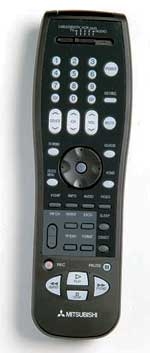Mitsubishi WD-52525 52-inch DLP HDTV Page 3
PICTURE QUALITY After a thorough calibration (see "in the lab"), I fired up my progressive-scan DVD player and popped in Mystic River. During the helicopter flyover of Boston that ends in Franklin Park , the grass of the baseball field and the leaves of the trees appeared lush and vibrant, revealing subtle variations in the foliage. In later scenes, skin tones looked natural and balanced - from the pale face and arms of Annebeth Markum (Laura Linney) in the morning light to the red-faced rage and despair of Jimmy Markum (Sean Penn) when he learns of his daughter's fate.
 Like all DLP TVs, the WD-52525 can't match the deep, inky blacks you get from big-screen CRT sets, but dark shots still revealed plenty of shadow detail. When Celeste Boyle (Marcia Gay Harden) returns home to find her husband (Tim Robbins) watching vampire movies in a dim room, wrinkles on her face were plainly visible. Although shadows in the background didn't quite go to black, they were clean, with generally smooth gradations between darker and lighter areas. Video noise, which appears as roiling pixels in dark areas, was also much less of a problem than on most other DLP HDTVs I've seen.
Like all DLP TVs, the WD-52525 can't match the deep, inky blacks you get from big-screen CRT sets, but dark shots still revealed plenty of shadow detail. When Celeste Boyle (Marcia Gay Harden) returns home to find her husband (Tim Robbins) watching vampire movies in a dim room, wrinkles on her face were plainly visible. Although shadows in the background didn't quite go to black, they were clean, with generally smooth gradations between darker and lighter areas. Video noise, which appears as roiling pixels in dark areas, was also much less of a problem than on most other DLP HDTVs I've seen.
I did occasionally see brief red, green, and blue doubles of brighter objects - for example, in the sunlit white shirts of the churchgoers or the bright light under the door of the morgue waiting room. But to its credit, the Mitsubishi didn't produce these "rainbow effects" as often as other DLP sets in my experience.
|
Turning to HDTV, I checked out the set's off-air digital TV tuner and found its performance to be not quite as good as that of the tuner in our Dish Network satellite receiver. At S&V's indoor testing facility, the Dish receiver was able to pull in the Fox digital channel, but the Mitsubishi couldn't lock onto the signal without breaking up. Next I scanned Dish's satellite channels before settling on the Home Run Derby on ESPN HD. The picture was simply stunning. I could see the shadows of the dirt clods under Lance Berkman's cleats as well as the enraptured expressions of fans in the crowd as he knocked one ball after another out of the park. Wrinkles on spectator George Bush, Sr.'s neck were also plainly visible, and I could even read the lettering on the uniform of a kid way out in left field. The image appeared rock-solid, without any jitter on graphics, like the score box at the top of the screen. Overall, the high-def picture was striking.
BOTTOM LINE With its cavalcade of features and input options, the WD-52525 represents the cutting edge of DLP technology. It has one of the cleanest, most accurate pictures I've seen in a rear-projection DLP HDTV to date, and its user friendliness and smart style should really please buyers looking for a less expensive alternative to plasma.
In the Lab
Color temperature (Low color temperature before/after calibration) Low window (20-IRE) .............. 8,004/6,824 K High window (100-IRE) ........... 7,434/6,526 K
Brightness (100-IRE window before/after calibration): 104/40.5 ftL
The WD-52525 was set to maximum contrast out of the box, resulting in an extremely bright image. Its initial grayscale with the Warm color-temperature setting was a little blue. After calibration, grayscale was significantly better, and peak brightness, though still high, was much lower. (Calibration needs to be performed by a qualified technician with specialized equipment, so discuss it with your dealer before purchase, or call the Imaging Science Foundation at 561-997-9073.)
The black-enhancement control actually adjusts brightness on the fly. I left it turned off, and the TV did an excellent job of keeping the level of black consistent. While it had no trouble displaying blacker-than-black content, the set did clip whites on its component-video input. This can translate into lost detail in very bright areas of DVD images. Overscan was negligible, and color decoding was very good. Mitsubishi's ColorPerfect controls allowed me to, yes, make them perfect, resulting in excellent color saturation. Once I adjusted sharpness and turned off the DefinEdge control, there was no sign of edge enhancement.
- D.K













































